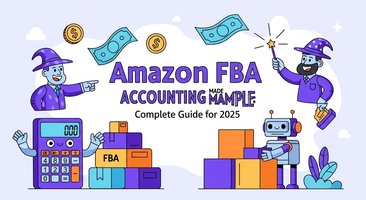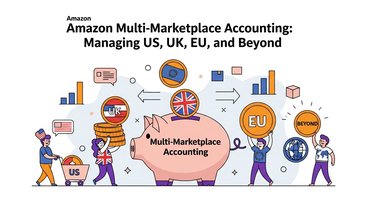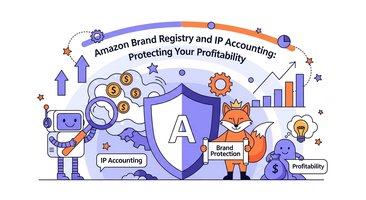Choosing between Amazon Seller Central and Vendor Central significantly impacts your accounting processes, cash flow, and overall business operations. While both platforms provide access to Amazon's massive customer base, they operate under fundamentally different business models that require distinct accounting approaches.
This comprehensive guide breaks down the key differences between these platforms and explains how each affects your accounting requirements, helping you make informed decisions about your Amazon strategy.
Understanding the Two Amazon Business Models
The choice between Seller Central and Vendor Central determines whether you're selling directly to consumers or selling wholesale to Amazon itself. This fundamental difference creates cascading effects throughout your entire accounting system.
Amazon Seller Central Overview
Seller Central operates as a marketplace where you maintain ownership of your inventory until the point of sale. You set your own prices, manage customer relationships (with Amazon's help), and retain control over your brand presentation.
Key characteristics of Seller Central:
- You own inventory until it sells
- You set retail prices
- You receive customer payments (minus Amazon's fees)
- You handle customer service (or Amazon does for FBA)
- You maintain direct relationships with customers
Amazon Vendor Central Overview
Vendor Central functions as a wholesale relationship where Amazon purchases your products and resells them under their own retail operation. Amazon becomes your customer, not the end consumer.
Key characteristics of Vendor Central:
- Amazon purchases your inventory wholesale
- Amazon sets retail prices
- Amazon handles all customer relationships
- Amazon manages marketing and advertising
- You invoice Amazon directly as a wholesale customer
Revenue Recognition Differences
The revenue recognition timing and methods differ significantly between these two platforms, impacting your financial statements and cash flow management.
Seller Central Revenue Recognition
With Seller Central, revenue recognition follows traditional retail patterns:
Point of Sale Recognition: Revenue is recognized when the customer purchases your product, regardless of when Amazon pays you.
Gross vs Net Reporting: You record gross sales amounts and then deduct Amazon's fees as separate line items, providing clear visibility into fee impacts.
Return Handling: Customer returns are processed as negative sales transactions, with inventory returning to your available stock.
Vendor Central Revenue Recognition
Vendor Central operates under wholesale accounting principles:
Purchase Order Fulfillment: Revenue is recognized when you fulfill Amazon's purchase orders, not when end customers buy the products.
Net Reporting: You invoice Amazon for the wholesale amount only, with no visibility into retail pricing or end-customer transactions.
No Return Processing: Amazon owns the inventory after purchase, so returns don't directly impact your accounting records.
Cash Flow and Payment Timing
Cash flow management varies dramatically between the two platforms, affecting your working capital requirements and financial planning.
Seller Central Cash Flow
Seller Central creates a retail cash flow pattern:
- Payments arrive every 14 days (or daily for eligible sellers)
- Revenue fluctuates based on consumer demand
- Seasonal variations directly impact your cash flow
- Amazon may hold reserves for new sellers or high-risk categories
Cash Flow Advantages:
- Direct correlation between sales performance and revenue
- Ability to adjust pricing for immediate cash flow impact
- No minimum order quantities from Amazon
Cash Flow Challenges:
- Unpredictable payment timing due to reserves
- Seasonal fluctuations can create cash flow gaps
- Fee deductions reduce net payments
Vendor Central Cash Flow
Vendor Central follows wholesale cash flow patterns:
- Payment terms typically range from 30-90 days
- More predictable payment amounts based on purchase orders
- Less seasonal variation in payment timing
- Larger individual payments but less frequent
Cash Flow Advantages:
- More predictable payment schedules
- Larger bulk payments improve cash flow planning
- No payment reserves or holds
Cash Flow Challenges:
- Longer payment cycles require more working capital
- Less control over order timing and quantities
- Chargebacks and deductions can impact payments
Inventory Management and Accounting
Inventory accounting requirements differ significantly between platforms, affecting your cost tracking and valuation methods.
Seller Central Inventory Accounting
With Seller Central, you maintain ownership until sale:
Perpetual Inventory System: Track inventory quantities and costs in real-time as sales occur.
Cost of Goods Sold Calculation: COGS includes product costs plus Amazon fees (referral, fulfillment, storage).
Inventory Valuation: Choose between FIFO, LIFO, or weighted average methods based on your business needs.
Write-offs and Adjustments: Handle damaged, lost, or expired inventory through adjustment entries.
Vendor Central Inventory Accounting
Vendor Central simplifies inventory tracking:
Wholesale Sales Model: Inventory is sold in bulk to Amazon, simplifying cost tracking.
Simplified COGS: Cost of goods sold equals the wholesale cost of products sold to Amazon.
No Ongoing Inventory Tracking: Once sold to Amazon, inventory is no longer your responsibility.
Bulk Transactions: Fewer but larger inventory transactions to track and reconcile.
Tax Implications and Compliance
Tax compliance requirements vary significantly between the two platforms, affecting your reporting obligations and potential liabilities.
Seller Central Tax Considerations
Seller Central creates complex tax obligations:
Sales Tax Nexus: FBA inventory creates nexus in multiple states, requiring sales tax registration and compliance.
Marketplace Facilitator Laws: Amazon collects and remits sales tax in many states, but you remain ultimately responsible.
Income Tax Reporting: Report gross sales and deduct Amazon fees as business expenses.
International Considerations: Multi-marketplace selling creates additional tax complexities.
Vendor Central Tax Considerations
Vendor Central offers simplified tax compliance:
No Sales Tax Collection: Amazon handles all sales tax obligations as the retailer.
Wholesale Tax Treatment: Standard B2B tax rules apply to your relationship with Amazon.
Simplified Reporting: Invoice Amazon like any other wholesale customer.
Reduced Nexus Concerns: Wholesale relationships typically don't create retail nexus obligations.
Fee Structures and Accounting Treatment
Understanding how Amazon fees work on each platform helps you account for costs accurately and optimize profitability.
Seller Central Fee Structure
Seller Central fees are deducted from your gross sales:
Referral Fees: 6-45% of sale price depending on category (typically 8-15%)
- Account for these as cost of goods sold
- Track by product category for profitability analysis
FBA Fees: Variable based on size, weight, and season
- Include in cost of goods sold calculations
- Monitor for seasonal variations
Storage Fees: Monthly charges based on inventory volume
- Allocate across inventory as carrying costs
- Watch for long-term storage fee triggers
Advertising Fees: Optional but important for visibility
- Klavena's advertising accounting categorization helps track these costs as advertising expenses
Vendor Central Fee Structure
Vendor Central has different cost structures:
No Direct Fees: Amazon doesn't charge traditional marketplace fees
Wholesale Pricing: You set wholesale prices that Amazon marks up
Marketing Contributions: Amazon may request marketing support funding
Operational Deductions: Potential chargebacks for compliance issues
Technology and Automation Considerations
Accounting automation becomes crucial for managing the complexity of either platform, but the requirements differ significantly.
Seller Central Automation Needs
Seller Central requires comprehensive automation due to transaction volume:
- Automated fee categorization for multiple fee types
- Real-time inventory tracking and valuation
- Multi-marketplace consolidation
- Sales tax compliance automation
- Customer return processing
Klavena's Seller Central Support includes:
- Automated transaction categorization for all Amazon fee types
- Real-time inventory tracking with cost basis calculations
- Integrated financial reporting with FBA-specific metrics
- Automated sales tax compliance features
Vendor Central Automation Needs
Vendor Central has simpler automation requirements:
- Purchase order tracking and fulfillment
- Invoice generation and payment tracking
- Wholesale customer management
- Basic inventory movement tracking
Making the Right Choice for Your Business
The decision between Seller Central and Vendor Central depends on multiple factors beyond just accounting complexity.
Choose Seller Central When:
- You want control over pricing and brand presentation
- You can manage complex accounting requirements
- You prefer direct customer relationships
- You want to scale with multiple products and marketplaces
- You have the resources to handle tax compliance
Choose Vendor Central When:
- You prefer simplified accounting and tax obligations
- You want predictable wholesale relationships
- You have limited resources for complex compliance
- You're comfortable with Amazon controlling pricing and presentation
- You want to focus on manufacturing rather than retail operations
Transitioning Between Platforms
Some businesses transition from Seller Central to Vendor Central or vice versa. Understanding the accounting implications helps ensure smooth transitions.
Seller Central to Vendor Central Transition
Accounting Changes Required:
- Simplify chart of accounts structure
- Adjust revenue recognition policies
- Modify inventory tracking systems
- Update tax compliance procedures
Considerations:
- Existing FBA inventory needs to be handled
- Customer relationships transfer to Amazon
- Historical data comparisons become complex
Vendor Central to Seller Central Transition
Accounting Changes Required:
- Expand chart of accounts for fee tracking
- Implement detailed inventory management
- Establish sales tax compliance systems
- Set up customer return processing
Considerations:
- Significantly increased accounting complexity
- Need for automation tools becomes critical
- Tax compliance obligations expand dramatically
Best Practices for Each Platform
Implementing platform-specific best practices ensures accurate accounting and optimal business performance.
Seller Central Best Practices
Monthly Reconciliation:
- Reconcile settlement reports with accounting records
- Verify inventory levels and movements
- Review fee calculations for accuracy
- Monitor sales tax compliance across states
Performance Monitoring:
- Track profitability by product and marketplace
- Monitor inventory turnover and storage costs
- Analyze advertising spend effectiveness
- Review customer return patterns
Automation Implementation:
- Use specialized ecommerce accounting software
- Automate fee categorization and inventory tracking
- Implement sales tax compliance automation
- Set up real-time financial reporting
Vendor Central Best Practices
Purchase Order Management:
- Track PO fulfillment and payment timing
- Monitor for chargebacks and deductions
- Maintain accurate wholesale pricing records
- Document all Amazon communications
Relationship Management:
- Maintain regular communication with vendor managers
- Track performance metrics Amazon provides
- Document any operational requirements
- Monitor for policy changes that affect accounting
Conclusion
The choice between Amazon Seller Central and Vendor Central fundamentally shapes your accounting requirements, cash flow patterns, and operational complexity. While Vendor Central offers simplicity, Seller Central provides more control and potentially higher profitability at the cost of increased accounting complexity.
For businesses choosing Seller Central, investing in proper accounting automation becomes essential for managing the platform's complexity effectively. Klavena's specialized support for Seller Central operations helps businesses handle the intricate fee structures, inventory tracking, and compliance requirements while maintaining clear visibility into profitability.
Understanding these differences upfront helps you make informed decisions about your Amazon strategy and ensures your accounting systems can support your chosen approach effectively. Whether you're just starting on Amazon or considering a platform transition, proper accounting foundation will support your long-term success on the platform.





